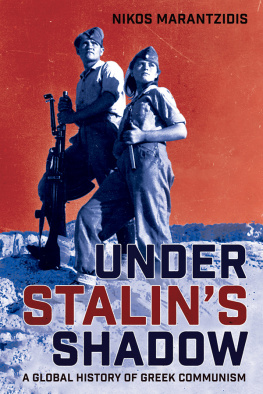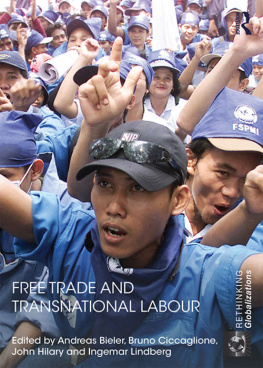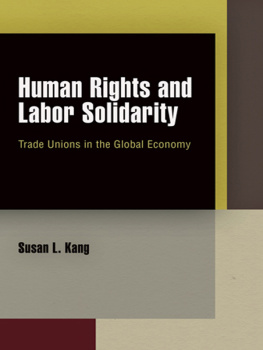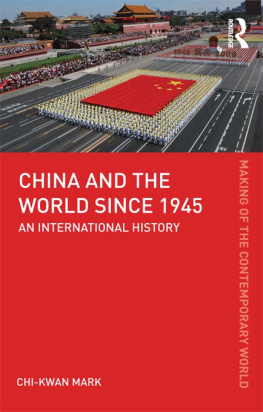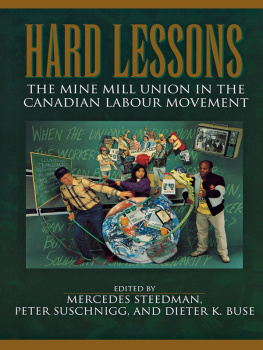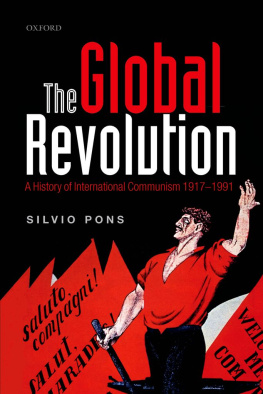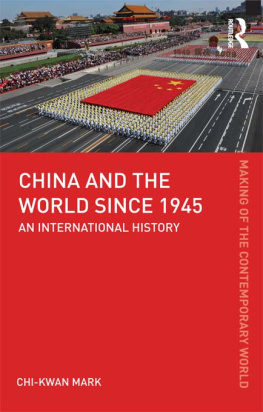THE AMSTERDAM INTERNATIONAL
The publication of this book was made possible thanks to the support of:
The Netherlands Organisation for Scientific Research (NWO)
Amsab-Institute of Social History
The International Association of Labour History Institutions (IALHI)
The Amsterdam International
The World of the International Federation of Trade Unions (IFTU), 19131945
Geert van Goethem
Archive and Museum of the Belgian Labour Movement, Belgium
First published 2006 by Ashgate Publishing
Reissued 2018 by Routledge
2 Park Square, Milton Park, Abingdon, Oxon OX14 4RN
711 Third Avenue, New York, NY 10017, USA
Routledge is an imprint of the Taylor & Francis Group, an informa business
Geert Van Goethem 2006
Geert Van Goethem has asserted his moral right under the Copyright, Designs and Patents Act, 1988, to be identified as the author of this work.
All rights reserved. No part of this book may be reprinted or reproduced or utilised in any form or by any electronic, mechanical, or other means, now known or hereafter invented, including photocopying and recording, or in any information storage or retrieval system, without permission in writing from the publishers.
A Library of Congress record exists under LC control number: 2005005336
Notice:
Product or corporate names may be trademarks or registered trademarks, and are used only for identification and explanation without intent to infringe.
Publishers Note
The publisher has gone to great lengths to ensure the quality of this reprint but points out that some imperfections in the original copies may be apparent.
Disclaimer
The publisher has made every effort to trace copyright holders and welcomes correspondence from those they have been unable to contact.
ISBN 13: 978-0-815-39745-8 (hbk)
ISBN 13: 978-1-351-14776-7 (ebk)
Contents
- 1 THE WORLD OF THE INTERNATIONAL FEDERATION OF TRADE UNIONS
Amsterdam, Berlin, and Paris - 2 THE DISCORDANT CLAMOUR FOR INTERNATIONAL UNITY
The Red Temptation of the International Federation of Trade Unions - 3 SUBORDINATE OR PARTNER?
The Difficult Relationship between the IFTU, as the Umbrella Organisation of National Unions, and the International Trade Secretariats - 4 GENEVA
The International Labour Organisation and the Social Reform Programme of the IFTU - 5 'SEEKING PROBLEMS'
The Women's Division of the IFTU - 6 ISOLATIONISM OR LEADERSHIP
The American Federation of Labor and the International Federation of Trade Unions - 7 A FREE LABOUR MOVEMENT IN A WORLD WITHOUT FREEDOM
The IFTU against Fascism and Nazism - 8 BEYOND THE INTERNATIONAL FEDERATION OF TRADE UNIONS
The Path to the World Federation of Trade Unions - 9 UNDER COVER
The Secret Services of the International Trade Union Movement
- 1 THE WORLD OF THE INTERNATIONAL FEDERATION OF TRADE UNIONS
Amsterdam, Berlin, and Paris - 2 THE DISCORDANT CLAMOUR FOR INTERNATIONAL UNITY
The Red Temptation of the International Federation of Trade Unions - 3 SUBORDINATE OR PARTNER?
The Difficult Relationship between the IFTU, as the Umbrella Organisation of National Unions, and the International Trade Secretariats - 4 GENEVA
The International Labour Organisation and the Social Reform Programme of the IFTU - 5 'SEEKING PROBLEMS'
The Women's Division of the IFTU - 6 ISOLATIONISM OR LEADERSHIP
The American Federation of Labor and the International Federation of Trade Unions - 7 A FREE LABOUR MOVEMENT IN A WORLD WITHOUT FREEDOM
The IFTU against Fascism and Nazism - 8 BEYOND THE INTERNATIONAL FEDERATION OF TRADE UNIONS
The Path to the World Federation of Trade Unions - 9 UNDER COVER
The Secret Services of the International Trade Union Movement
Guide
Labour history has often been a fertile area of history. Since the Second World War its best practioners such as E.P. Thompson and E.J. Hobsbawm, both Presidents of the British Society for the Study of Labour History have written works which have provoked fruitful and wide-ranging debates and further research, and which have influenced not only social history but history generally. These historians, and many others, have helped to widen labour history beyond the study of organised labour to labour generally, sometimes to industrial relations in particular, and most frequently to society and culture in national and comparative dimensions.
The assumptions and ideologies underpining much of the older labour history have been challenged by feminist and later by postmodernist and anti-Marxist thinking. These challanges have often led to thoughtful reappraisals, perhaps intellectual equivalents of coming to terms with a new post-Cold War political landscape.
By the end of the twentieth century, labour history had emerged reinvigorated and positive from much introspection and external criticism. Very few would wish to confine its scope to the study of organised labour. Yet, equally, few would wish now to write the existence and influence of organised labour out of nations' histories, any more than they would wish to ignore working-class lives and focus only on the upper echelons.
This series of books provides reassessments of broad themes of labour history as well as some more detailed studies arising from recent research. Most books are single-authored but there are also volumes of essays centred on important themes or periods, some arising from major conferences organised by the Society for the Study of Labour History. The series also includes studies of labour organisations, including international ones, as many of these are much in need of a modern reassessment.
Chris Wrigley
British Society for the Study of Labour History
University of Nottingham
'The history of labor internationalism is a history of failure, of dreams disappointed, ideals compromised, and institutions corrupted'
(Victor Silverman)
Edo Fimmen had already predicted it in 1933: 'the judgement of history upon the labour movement in the years immediately following the war, and especially upon the leaders of that movement, is not likely to be a merciful one.'
The International Federation of Trade Unions (IFTU) was founded in July 1919 in Amsterdam. This 'Amsterdam International' declared war on war and wanted to liberate the workers from capitalism. For Edo Fimmen, one of the fathers of the IFTU, it had been clear ever since 1923 that things would take a different course, and for a long time, he kept on urging in vain for the international trade union movement to take a firm stand. It repeatedly brought him into conflict with the leaders of the IFTU, a conflict that was also partly personal.
On the facing page is a photograph of the leaders, the Executive Board of the International Federation of Trade Unions in 1930: sitting from left to right are Lon Jouhaux (France), Johannes Sassenbach (Germany), Walter Citrine (Great Britain), Walter Schevenels (Belgium), and Theodor Leipart (Germany); standing are Rudolf Tayerle (Czechoslovakia), Corneel Mertens (Belgium), and Hans Jacobsen (Denmark). In 1930, the IFTU had just recovered from a severe internal crisis. Its membership had grown steadily and had reached a record number of 13.5 million members in twenty-nine countries. It also had a new and stronger executive. In this photograph, the leaders radiate willpower and self-confidence. The future looked bright, and it shows. The picture was taken in July 1930 in Stockholm. The first storm clouds were already gathering on the horizon, but no-one could suspect that the next decade would be an infernal era of economic catastrophes, political crises, and armed conflicts. The world of the IFTU was an insecure and dangerous one. This is amply illustrated by the eminently fickle fortunes of the members of the Executive Committee: Lon Jouhaux was imprisoned during the war by the French Vichy regime and was deported to Germany in 1943. After the war, he became the leader of the Force Ouvrire and he was awarded the Nobel Peace Prize in 1951. Johannes Sassenbach, the German general secretary of the IFTU, was close to retirement in 1930; he retreated to Germany but was arrested by the Nazis and died in November 1940. The British president, Walter Citrine, had assumed leadership of the IFTU in 1928 and was one of the figureheads of both the British trade union movement and of Labour, together with Ernest Bevin. He was knighted in 1935 and even became Lord Citrine in 1947. The Belgian deputy general secretary, Walter Schevenels, succeeded Sassenbach in 1931. He led the struggle of the IFTU against Nazism and the aid campaigns of the international labour movement for the Spanish Republic. Schevenels spent the war in London and helped to create the World Federation of Trade Unions. With the support of the British, he tried consecutively, to become general secretary of the World Federation of Trade Unions and of the International Confederation of Free Trade Unions (ICFTU); both attempts failed. Theodor Leipart, the leader of the German trade union movement, was arrested on 2 May 1933 and his organisation was banned. Leipart survived his imprisonment, but died shortly after the end of the war. The Czech Rudolf Tayerl was arrested after the German invasion of his country and was one of the 120,000 people who were killed in the Mauthausen camp. Corneel Mertens was the general secretary of the Belgian Socialist union. He retired in 1939 and the war left him a sick man. Hans Jacobsen, the popular Danish union leader, retired in 1940 and died in 1943.


